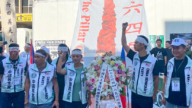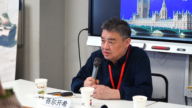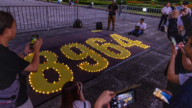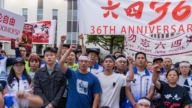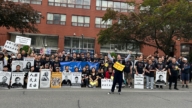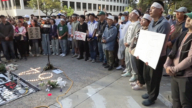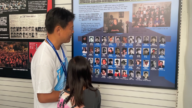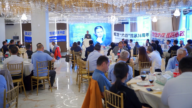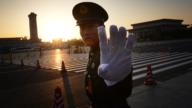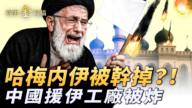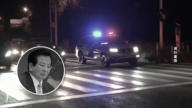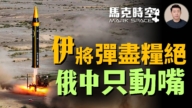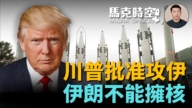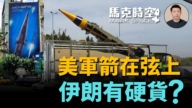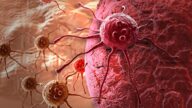【新唐人2014年04月28日讯】经过多年计划和筹款之后,由“香港市民支持民主爱国运动联合会”主持的《永久六四纪念馆》,26号在九龙尖沙咀正式开幕。香港“支联会”表示,设立目前全球唯一的“六四纪念馆”,是希望能保存历史,传承真相,呼唤良知,推动“平反六四”以及中国的民主发展。而评论认为,香港逐渐沦丧为中共的殖民地,香港成立“六四纪念馆”,标志着港人正式对中共政权说“不”。
支联会主席李卓人、副主席麦海华以及多位曾见证“八九民运”的香港嘉宾,在开幕仪式上,一起撕碎《人民日报》将学运定性为动乱的“四二六”社论影印本,作为开馆仪式。
1989年4月26号,中共喉舌《人民日报》发表社论,将在天安门广场悼念前改革派领导人胡耀邦逝世而引发的学生运动,定性为反革命动乱,从而激化了政府和人民的矛盾,并导致了“八九民主运动”,也后来演变成了“六四”惨案。
香港“六四纪念馆”特地选在25年后的这一天,正式对民众开放参观。
旅美中国社会问题研究人士张健表示,建立“六四纪念馆”,标志着香港人民对中国民主的担忧,对中国未来走向的关注,也标志着香港人民对自己的未来会被中共逐渐蚕食的担忧。
旅美中国社会问题研究人士张健:“香港由过去一个自由港,一直到回归到中共体制内之后,香港逐渐的沦丧为中共的殖民地。香港现在已经完全丧失了它的法制和民主这样一种精神,它再也不是亚洲的一个旗帜。”
张健认为,“六四纪念馆”开馆的这一天,就是标志着在这一个时间点上,对中共政权说“不”。
有50家世界各地的媒体、近百记者采访了“六四纪念馆”,包括《路透社》、《半岛电视台》等。
纪念馆下午开放三小时,众多参观者排起了长队等待入馆参观,不仅有香港人也有从中国大陆来的90后大学生。
不过,有10多名亲北京政府的团体人士在附近抗议,他们指责“永久六四博物馆”的筹建者是“叛徒”,并摆设街板展览,还一度对参观纪念馆的市民指骂。
过去几个星期以来,也有“六四纪念馆”同一幢建筑的其他业主,由于安全的担忧,要求纪念馆关闭。
多年来,中共从未提供“动用坦克和军队清场”而死亡的学生和市民数字,官媒也一直回避“六四”问题。但不可否认的是,“六四”事件是对中国近来发展方向影响最大的事件。
中共前领导人赵紫阳秘书鲍彤指出,泛滥全国的腐败、堕落和违法现象,是1989年后开始的。
原中共中央农村政策研究室研究员姚监复对“六四”的评价是:当权者用“六四”的鲜血保证了政权的“稳定”。
姚监复还指出,“六四”的枪声,毁灭了中国人对民主、自由的期望和追求理想、关心政治的热情,同时还封死了人们的嘴巴和良心:“惹不起,还躲不起!?”、“好死不如赖活着”成了人们的生活信条。中国人的道德感、责任感、使命感消失了,淡化了。
香港《新世纪》出版社负责人鲍朴也曾亲历“六四”,他感受到:“六四事件枪响之后,人人都知道这个政府,只要你上街他就会抓你甚至会开枪,政府从此以后也立下了规矩,只要公民去抗议,哪怕是和平的、是合法的,他们也要去镇压。”
不过,张健表示,“六四”后,对中共最坚定和最勇敢的反抗团体,就是信仰“真善忍”的“法轮功”团体。
张健:“他们弘扬真善忍,用这种理性和平非暴力的方式,来去和中共常年来做斗争,这是非常不容易的事情。所以我今天才说,真正中国人的脊梁、民族的骄傲,就是应该是这些大法的弟子们。”
4月25号,是法轮功和平上访“反迫害”的第一个日子。张健指出,把“六四纪念馆”开幕日定在法轮功“4.25”15周年纪念日后的这一天,也许是天意,是上天从另一方面对大法的支持。
采访/朱智善 编辑/宋风 后制/萧宇
The First June 4 Museum Opens In Hong Kong:
A Denial of The Chinese Communist Party.
After years of planning and fundraising, a permanent
museum to remember the Tiananmen Square Crackdown
on June 4 of 1989 has officially opened on April 26 in Hong
Kong’s Tsim Sha Tsui tourist district.
The Hong Kong Alliance in Support of Patriotic Democratic
Movements of China (the Alliance), said they built the
museum, currently the only one that commemorates the
June 4 Incident globally, to preserve and spread the truth.
In addition, the museum can serve as a call of conscience
and a promotion to China’s democratization.
Commentators said as Hong Kong was made its colony by
the Chinese Communist Party (CCP) opening of the June 4
Museum marked Hong Kong people saying “No” to the CCP.
Lee Cheuk-yan, chairman of the Alliance and Mak Hoi-wah,
vice chairman of the Alliance, attended the museum opening
ceremony along with many witnesses of China’s 1989 protests.
In the ceremony, they destroyed photocopies of the April 26
Editorial published by the People’s Daily, which called the
student movement a revolt.
On April 26, 1989, the party mouthpiece People’s Daily
published an article on the student movement motivated
by the death of former reformist party leader Hu Yaobang.
The article defined the students’ mourning activities
at the Tiananmen Square as an anti-CCP revolt.
This greatly intensified the conflicts between the Chinese
people and the CCP, which led to a massive democratic
movement followed by the massacre on June 4, 1989.
The opening date of June 4 museum was selected on the 25th
Anniversary of the April 26 Editorial.
The museum was officially opened to the public on that day.
Zhang Jian, a US-based China social issue researcher, said the
opening of June 4 museum marks how Hong Kong people are
worrying about China’s democratization and the state’s future.
Meanwhile, they also worry that the CCP is gradually
taking control of Hong Kong’s future.
Zhang Jian: ”Since the Handover, Hong Kong has been
gradually turned into the party’s colony from a free port.
Now Hong Kong has almost lost its principles in the ruling of
law and democracy, and so no longer serves as a banner in Asia.
Zhang Jian commented that, the opening of the June 4
museum marked Hong Kong’s people saying “No” to the
CCP at such as critical moment.
Along with Reuters and Al Jazeera, about fifty media from
all over the world and a hundred journalists reported on
the opening ceremony.
The museum was open for three hours in the afternoon.
Visitors that queued to enter the museum included not just
Hong Kong residents but also post-90’s undergraduates
from mainland China.
On the other hand, a dozen pro-CCP activists protested
near the museum.
They claimed organizers of the museum are “betrayers”.
They set up a street booth for propaganda and even
shouted swear words at museum visitors.
In the past few weeks, some business owners sharing the
same building with the museum also requested the museum
close due to safety concerns.
Over the years, the CCP has never mentioned a death toll in
its crackdown of students and civilians with tanks and troops.
All CCP official media never touch the topic of June 4 Incident.
It is still an undeniable fact that the incident is most
influential to China’s development direction since 1989.
Bao Tong, former secretary of CCP leader Zhao Ziyang, said
corruption, moral degeneration and all kinds of illegal acts
started to spread over the whole state after 1989.
Yao Jianfu, former State Council research fellow on rural
polices, said party leaders had chosen to maintain “stability”
of the CCP with blood in the June 4 Incident.
Yao Jianfu further commented that the 1989 crackdown
completely destroyed Chinese peoples’ expectations of
democracy and freedom, and passion for political awareness.
It shut down peoples’ mouths and killed their consciences.
“I cannot touch the problems but I can escape from them”
or “A living dog is better than a dead lion” became new
principles of Chinese people.
The consciousness of morality, responsibility and
vocation gradually disappeared in China.
Bao Pu, director of Hong Kong’s New Century Press,
experienced the June 4 Incident himself.
Bao said: ”After the crackdown on June 4, it became
clear to everyone that the CCP will arrest you or even
shoot you if you do any street protests.
The CCP also set the example that they will suppress any
protests even if they are peaceful and legal.”
Zhang Jian said, since the June 4 Incident, the group that
protests against the CCP most persistently and with the most
courage, are Falun Gong practitioners who believe in
“Truthfulness, Compassion and Tolerance”.
Zhang Jian: “They stick with the principle of ‘Truthfulness,
Compassion and Tolerance’, and have protested against
the CCP year on year in a rational and peaceful manner.
That is really something very difficult to do.
Therefore I can conclude now that China’s real strength
and pride are inside those Falun Gong practitioners.”
April 25 is also the first important date when Falun Gong
practitioners began their peaceful protests against the CCP
persecution in 1999.
Zhang Jian believes that, the June 4 museum opened right
after Falun Gong’s 15 anniversary of “April 25 Petition”.
This coincidence could be divine will that shows its
support of Falun Gong.
Interview/Zhu Zhishan Edit/SongFeng Post-Production/XiaoYu


